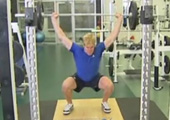If you have just gotten back into hockey and feel a bit sluggish or if you want to give yourself an edge over the other players, off ice foot speed drills increase your skating, stopping, and turning abilities without ever having to strap on skates. The off-ice drills you do emphasize explosive speed in your muscles so that you have a better first step, better acceleration, and arrive at the puck before your opponent does.
Off ice Foot Speed Drills Tips
Whenever you watch NHL players dance through scrums on the ice, you notice that their legs seemingly never stop moving. This is one of the first lessons that coaches drill into players — keep moving your feet at all time. The most effective way to increase foot speed is to generate more power from your legs as you push off against the ice. Leg exercises boost the calf and thigh muscles (the two largest muscles in the body) that push off and provide speed. These weight lifting routines include squats, leg extensions, and lunges.
Explode Into the Attack
The very first step you take on the ice rink will determine the speed at which you progress. The factor behind generating better speed on the first step is the amount of force you can generate from an at-rest position. Increasing this force is done by plyometric exercises, drills that make your legs push off from a complete stop to move the entire body. Plyometric workouts that hockey players can benefit from include a box routine, in which a box about thigh-high is jumped on to and off of in quick succession. Other plyometric workouts include running up and down steps, forwards and backwards. These drills need to be done in the minimum amount of time, or else they start generating endurance rather than burst strength.
Off ice Foot Speed Drills
If you have ever played a game of Twister, you know how difficult it can be to get one part of your body into a small area in a short amount of time. Off ice drills known as “dot drills” are similar to a stand-up game of Twister, since they require the player to move with rapid speed from one three-inch dot on a board to another three-inch dot. This creates faster footwork by conditioning the muscles of the lower body to respond to contact with a surface in less time, so that as you skate on the ice, you shave a fraction of a second off each push.
If you want more advice and guidance on furthering your hockey skills, we at HockeyOT can give you the assistance you require, whether you are a professional or just a fan of the game.














